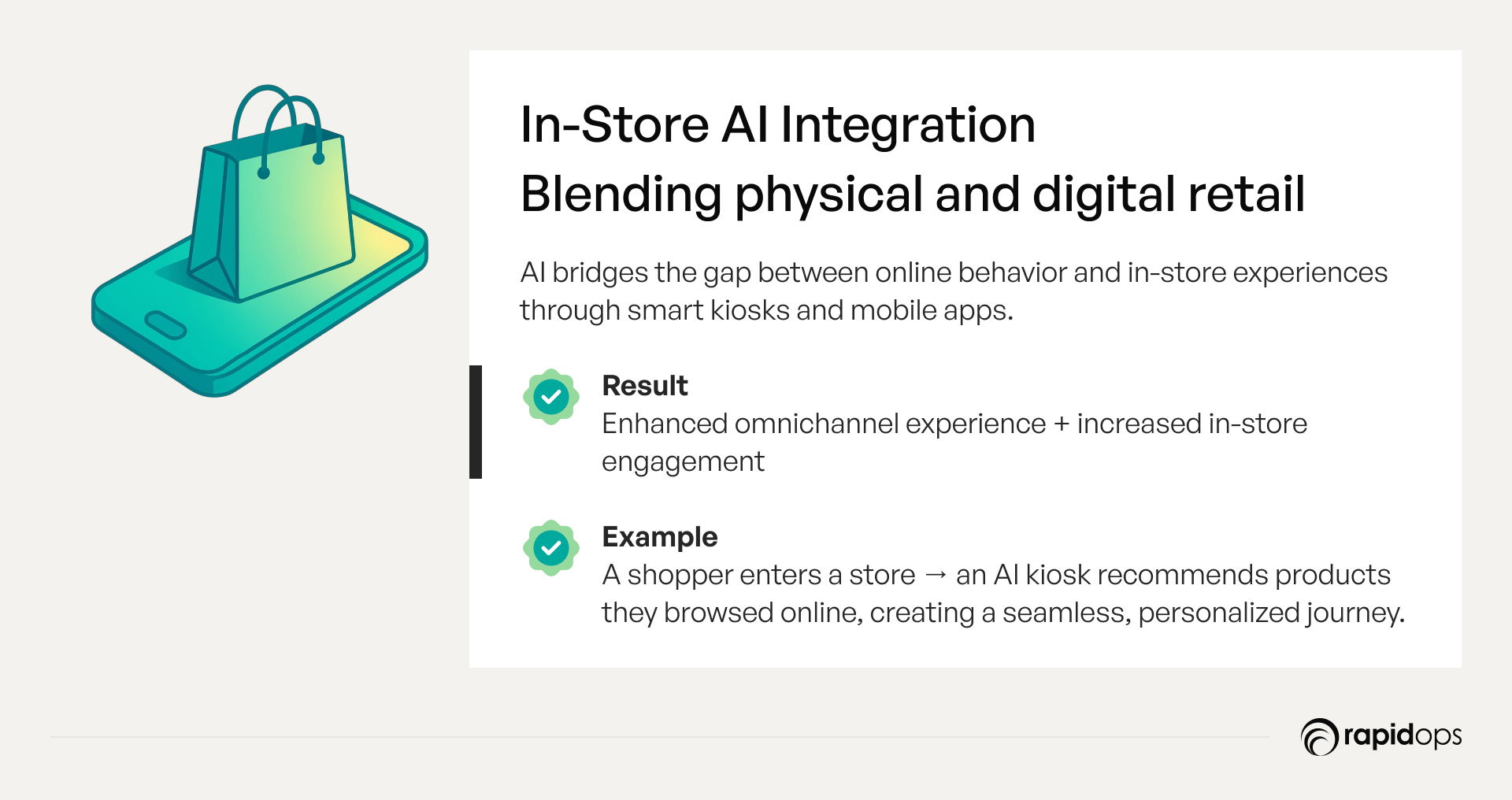- AI
- 18 min read
- January 2025
How an AI Recommendation System Works
Key Takeaways
In the fast-paced world of retail, where understanding customers is as critical as meeting their needs, AI recommendation systems have become game-changers.
If you’ve ever been impressed by how an online store seems to know exactly what you’re looking for, you’ve already encountered the magic of these systems. But have you ever wondered—how does it actually work?
As a business leader, you already understand the importance of delivering personalized experiences and staying ahead of customer expectations.
What you might be curious about is the inner mechanics: How do AI recommendation systems analyze data, predict preferences, and deliver those eerily accurate suggestions?
More importantly, how can you, as a retailer, harness this technology to transform your customer journeys and scale your business?
This article unpacks these questions, taking you behind the scenes of AI recommendation systems.
We’ll explore how they work, discuss their transformative potential in the retail industry, and provide insights into overcoming implementation challenges.
By the end, you’ll not only understand the system’s workings but also have a clear vision of how to leverage it for your retail business.
How AI recommendation systems work
Imagine a symphony orchestra, each musician playing their part to create a masterpiece. The violins, flutes, and percussion work in harmony, producing a sound that resonates deeply with the audience. Similarly, AI recommendation systems orchestrate a multitude of components, data points, and algorithms to create a personalized experience for each customer—a symphony of relevance.
At their core, AI recommendation systems are powered by the ability to analyze, learn, and predict. But before we dive into the process, let’s take a closer look at the essential components that make these systems work effectively.
Essential components of AI recommendation systems

1. Data inputs: The lifeblood of the system
AI recommendation systems rely heavily on data. This includes:
- Customer data: Browsing history, purchase patterns, search queries, and feedback.
- Product data: Attributes like price, category, brand, and specifications.
- Contextual data: Time of day, location, device type, or even weather conditions.
Together, these data points provide the raw material for generating recommendations.
2. Algorithms: The decision-making engine
Algorithms are the backbone of AI recommendation systems. These include:
- Collaborative filtering: Learning from the behaviors and preferences of similar users.
- Content-based filtering: Matching customer preferences with product attributes.
- Hybrid models: Combining multiple algorithms for better accuracy and relevance.
3. Machine learning models: The brain behind predictions
AI systems use machine learning to process data, identify patterns, and predict customer preferences. Over time, these models improve with more data, becoming smarter and more effective.
4. Infrastructure and scalability: The system’s foundation
A robust infrastructure is critical for handling large-scale data processing and real-time recommendations. Cloud platforms and big data technologies enable scalability, ensuring the system performs seamlessly, even with growing data volumes.
5. Integration framework: Seamlessly connecting systems
AI recommendation systems need to integrate smoothly with existing platforms like e-commerce websites, CRM tools, and inventory management systems. This ensures data flows seamlessly and recommendations are delivered at the right time.
So, how an AI recommendation system works?
With these essential components in place, the system can move on to its core process. Now, let’s break down how an AI recommendation system works—step by step.
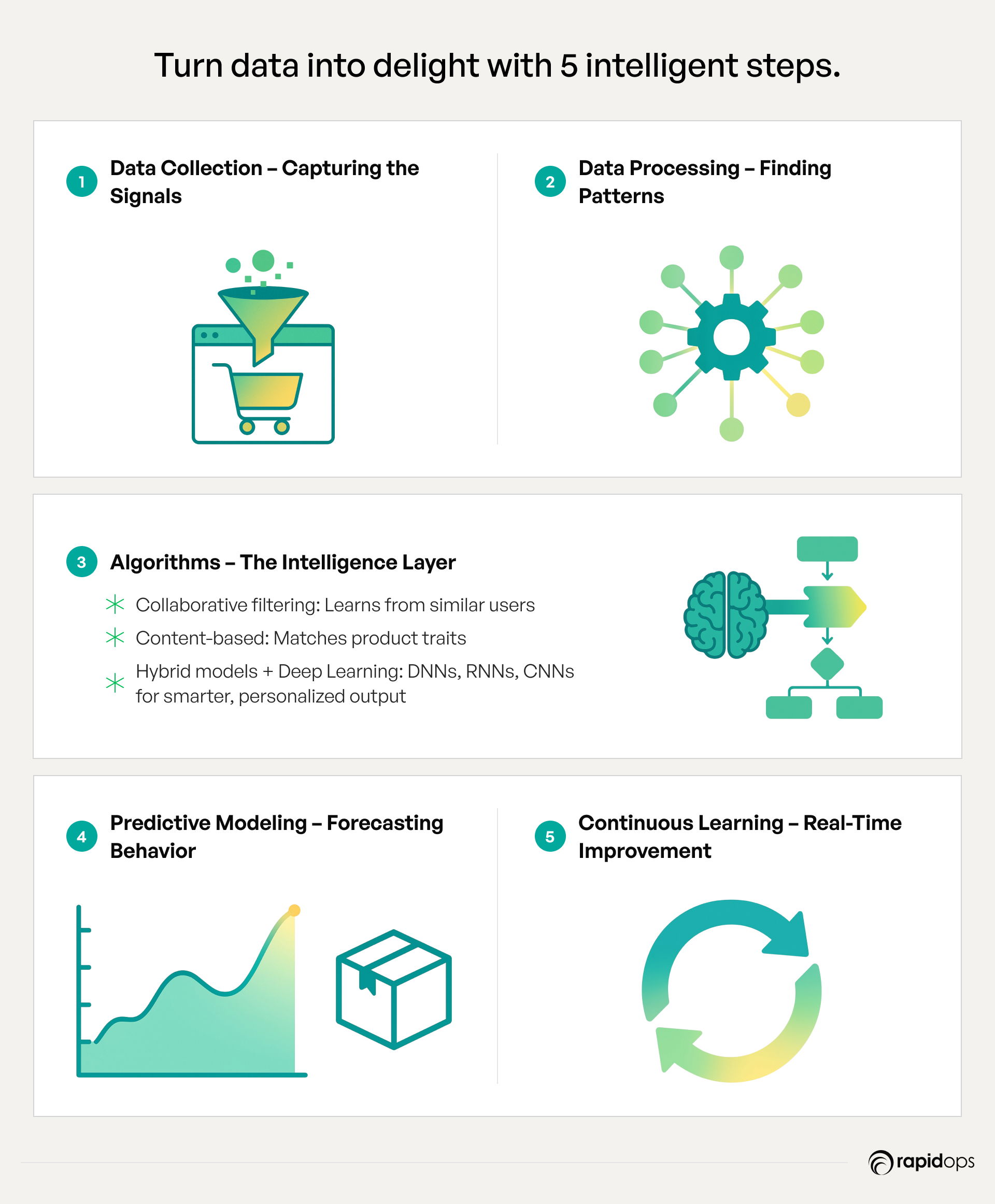
1. Data collection: Gathering the notes
Every great composition begins with understanding the melody. AI recommendation systems start by collecting a wealth of data—customer browsing behavior, purchase history, search patterns, ratings, and even time spent viewing specific products.
In the retail industry, this data comes from both online and offline sources, such as e-commerce platforms, loyalty programs, and in-store interactions.
For example, when a customer scrolls through an online store, clicks on a product, and adds it to their cart, the system takes note of these actions. This data forms the foundation of the recommendation process.
2. Data processing: Finding the harmony
Once the data is collected, the system processes it, identifying patterns and relationships that even the most astute human analyst might overlook. This is where machine learning takes center stage.
The algorithms segment customers into groups based on shared behaviors or preferences, enabling the system to predict what each customer might want next.
In the retail world, this could mean analyzing data to discover that customers who buy running shoes are likely to purchase fitness apparel in the next 30 days. The AI system identifies these connections and uses them to craft precise recommendations.
3. Algorithms: The conductors of the symphony
AI recommendation systems rely on three key types of algorithms, each with its unique role in creating tailored experiences:
- Collaborative filtering: Think of this as crowdsourcing preferences. The system identifies similarities between customers, suggesting products based on what others with similar behaviors have purchased or liked.
- Example: A customer buys a coffee machine, and the system recommends coffee pods based on purchases by other coffee machine buyers.
- Content-based filtering: This approach focuses on the attributes of products. If a customer likes a particular style of dress, the system suggests similar dresses with matching features.
- Example: A customer interested in minimalistic furniture is shown items with clean lines and neutral tones.
- Hybrid models: Combining the strengths of both collaborative and content-based filtering, hybrid models offer the best of both worlds. These systems ensure recommendations are both accurate and diverse, creating a balanced experience.
The role of deep learning in hybrid models
Advances in deep learning have significantly enhanced the power of hybrid recommendation systems. Modern systems integrate deep learning techniques like:
- Deep Neural Networks (DNNs): DNNs process large volumes of data to uncover complex relationships and deliver more nuanced recommendations.
- Autoencoders: These are used for dimensionality reduction and feature extraction, enabling systems to focus on the most relevant attributes of products and customers.
- Recurrent Neural Networks (RNNs): RNNs excel at analyzing sequential data, such as browsing history or purchase timelines, to predict future behavior.
- Convolutional Neural Networks (CNNs): CNNs are particularly effective in analyzing visual data, such as images of products, to enhance content-based filtering.
Example: A hybrid system powered by deep learning might use RNNs to analyze a customer’s recent purchase sequence and CNNs to recommend visually similar items from the catalog, delivering a holistic experience.
4. Predictive modeling: Crafting the future melody
The magic happens when AI systems predict what a customer will want next. Using historical data and real-time inputs, these models anticipate needs before the customer even realizes them.
For example, an AI system might predict that a frequent shopper of skincare products will soon run out of their favorite moisturizer and proactively recommend a reorder.
These predictive models are trained using large datasets and optimized through advanced techniques such as gradient descent, hyperparameter tuning, and cross-validation.
Continuous learning ensures the models adapt to changing customer behaviors, keeping recommendations relevant and precise.
By incorporating reinforcement learning, the system also improves over time based on real-time feedback, such as clicks and purchases, ensuring dynamic, customer-first experiences.
5. Continuous learning: Perfecting the symphony
AI systems don’t rest.
They learn and evolve with every interaction, refining their recommendations as more data becomes available.
This means the longer a system operates, the smarter and more accurate it becomes—a crucial advantage for retailers aiming to stay ahead in a dynamic market.
Now that we’ve unraveled the mechanics of AI recommendation systems, it’s time to see them in action.
In the next section, we’ll explore how these systems are transforming the retail industry, creating personalized shopping journeys, increasing customer retention, and driving revenue growth.
Use cases of how AI enhances customer experiences
Imagine walking into a store that knows exactly what you need, even before you do.
As you browse, your favorite products are neatly displayed, complemented by items you didn’t realize you’d love until now.
This is the power of AI recommendation systems in retail—a technology that transforms casual shoppers into loyal customers and browsers into buyers.
In the retail industry, where customer expectations are sky-high, AI recommendation systems have become indispensable.
Let’s dive into how these systems are redefining customer experiences and unlocking growth opportunities for retailers.
1. Personalized product recommendations: Turning insights into action
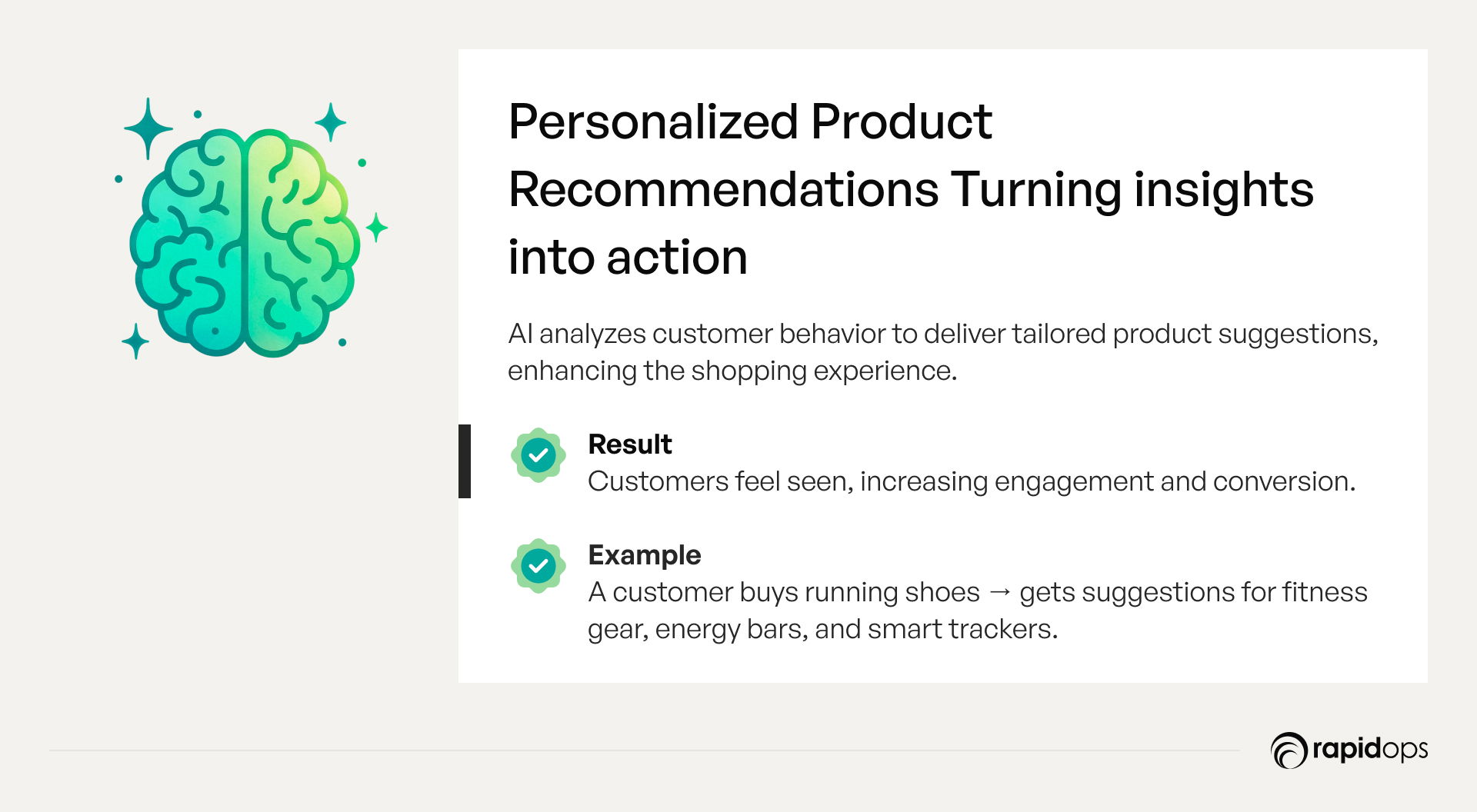
The cornerstone of AI recommendation systems in retail is personalization.
These systems analyze customer data to understand individual preferences and provide tailored product suggestions.
The result? Customers feel valued, and their shopping experiences become seamless.
Example: An online retailer uses collaborative filtering to recommend products based on similar customer behaviors.
A customer purchasing running shoes might see suggestions for fitness gear, energy bars, or workout trackers—all items they’re likely to need.
2. Dynamic pricing strategies: Offering the right price at the right time
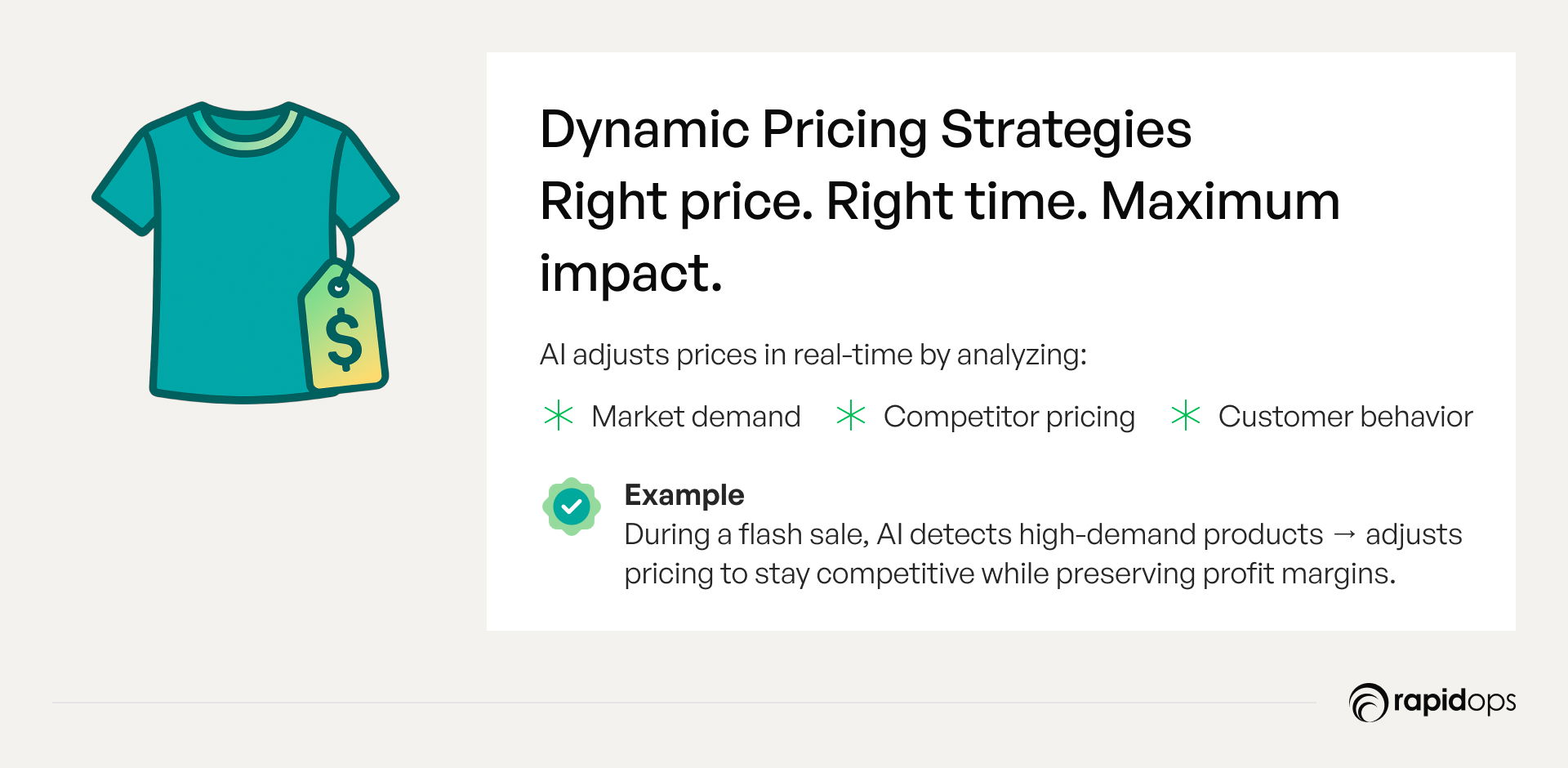
AI doesn’t just recommend products; it ensures they’re priced optimally.
By analyzing market trends, competitor pricing, and customer willingness to pay, AI systems can dynamically adjust prices to maximize sales and profitability.
Example: During a flash sale, AI can identify which products are in high demand and adjust their prices in real-time to attract customers without compromising margins.
3. Cross-selling and upselling opportunities: Increasing basket value
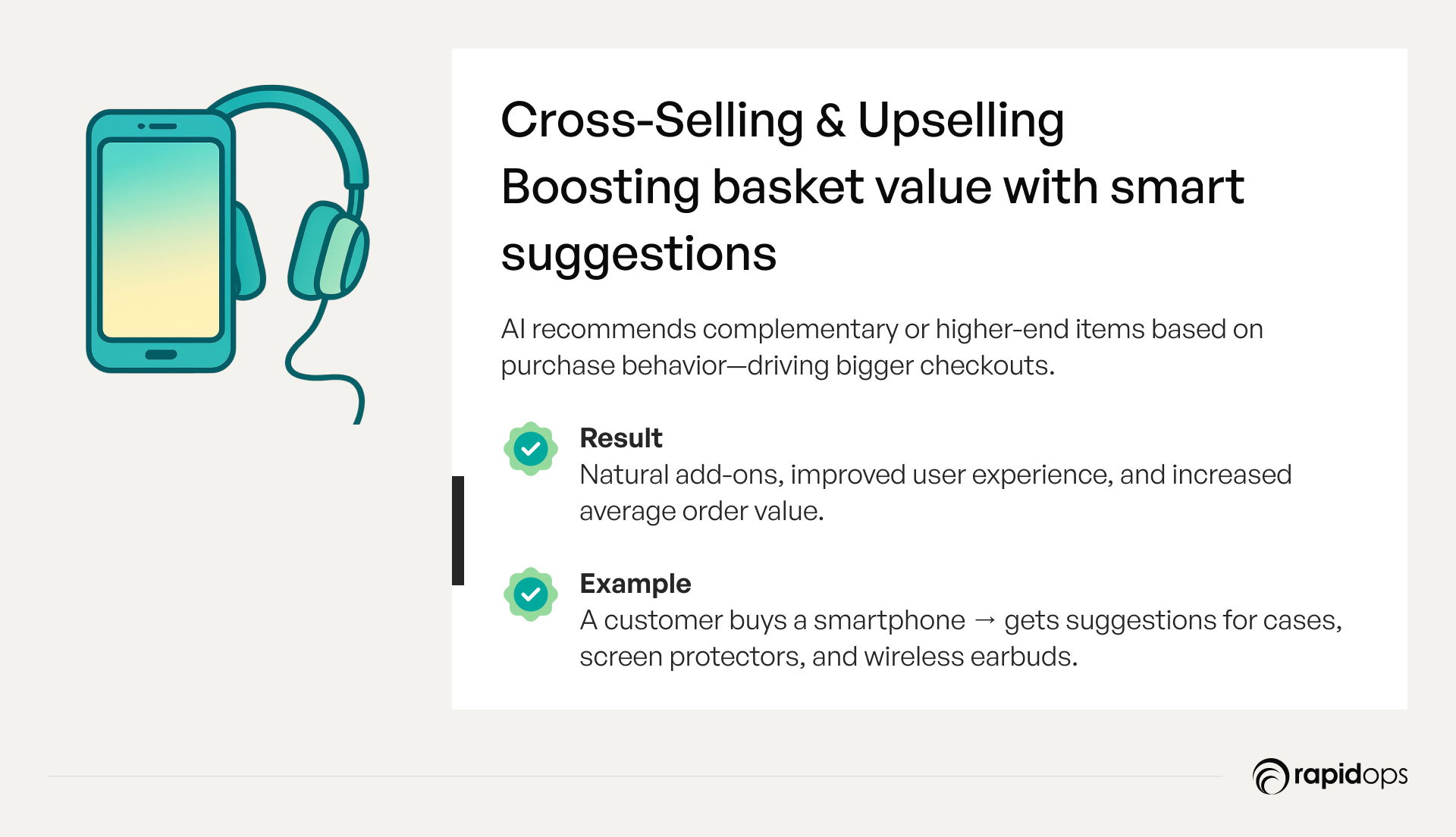
AI recommendation systems excel at identifying complementary products that customers are likely to buy together, encouraging cross-selling and upselling.
Example: A customer buying a smartphone might receive recommendations for cases, screen protectors, and wireless earbuds. These suggestions feel natural and enhance the overall shopping experience, increasing the average order value.
4. In-store AI integration: Bridging physical and digital experiences
AI isn’t confined to online shopping—it’s making waves in physical retail too.
In-store AI systems, such as kiosks and mobile apps, offer personalized suggestions based on customer preferences and past purchases.
Example: A customer visiting a store is greeted by an AI-driven kiosk that suggests products they’ve browsed online, creating a seamless omnichannel experience.
5. Inventory optimization: Meeting demand without overloading supply
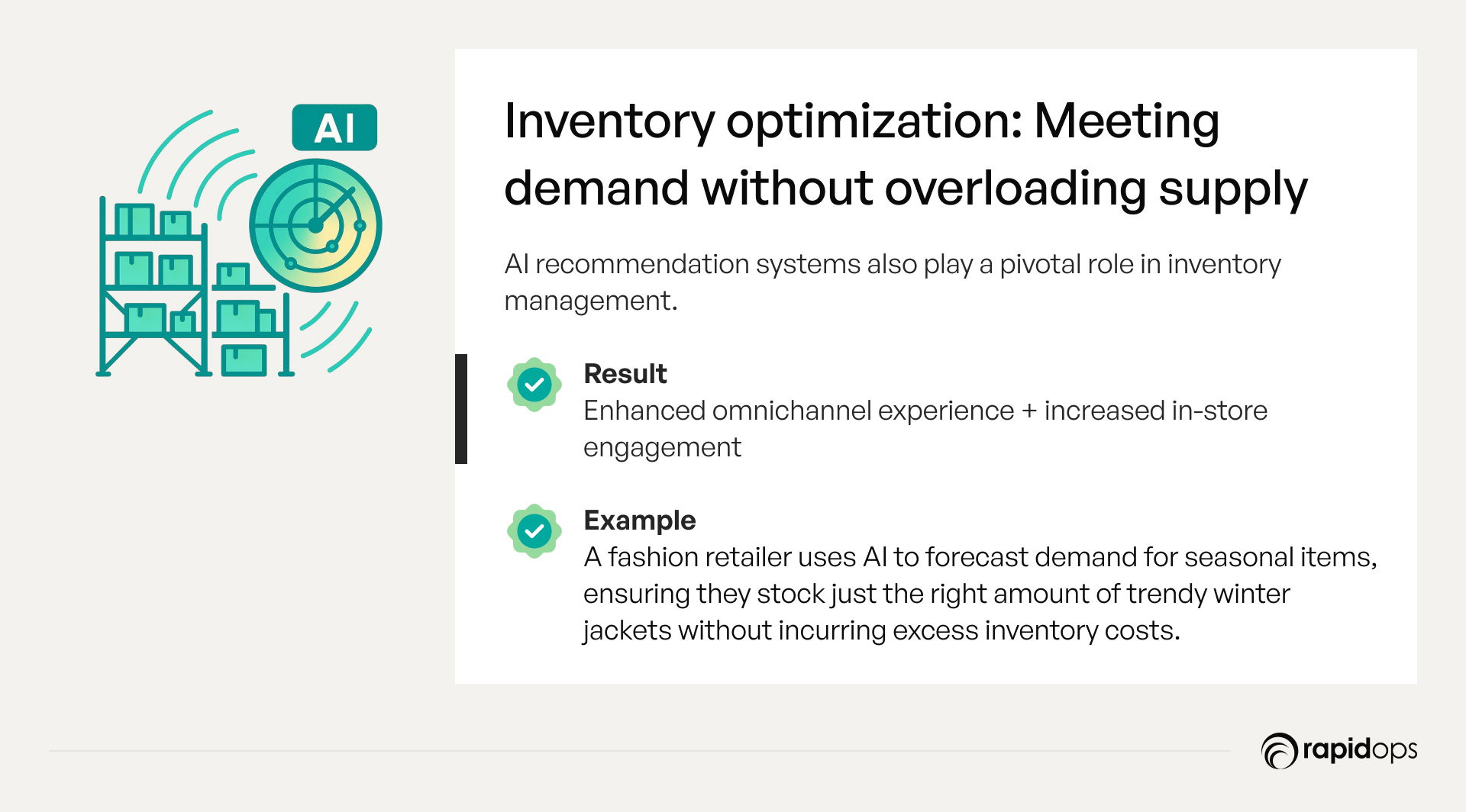
AI recommendation systems also play a pivotal role in inventory management.
By predicting customer demand, these systems ensure that popular products are always in stock while minimizing overstock of less popular items.
Example: A fashion retailer uses AI to forecast demand for seasonal items, ensuring they stock just the right amount of trendy winter jackets without incurring excess inventory costs.
Why retailers love AI recommendation systems
For retail business owners, these use cases translate into tangible benefits:
- Enhanced customer satisfaction: Shoppers enjoy a personalized experience tailored to their needs.
- Increased sales and revenue: By offering relevant suggestions, retailers can drive higher conversion rates and larger basket sizes.
- Improved operational efficiency: AI optimizes pricing, inventory, and marketing strategies, freeing up time and resources for strategic initiatives.
While the benefits of AI recommendation systems are clear, implementing them isn’t without its hurdles. In the next section, we’ll explore the challenges retailers face—such as legacy systems and integration difficulties—and discuss how to overcome them with the right approach.
Overcoming Challenges: Integrating AI recommendation systems
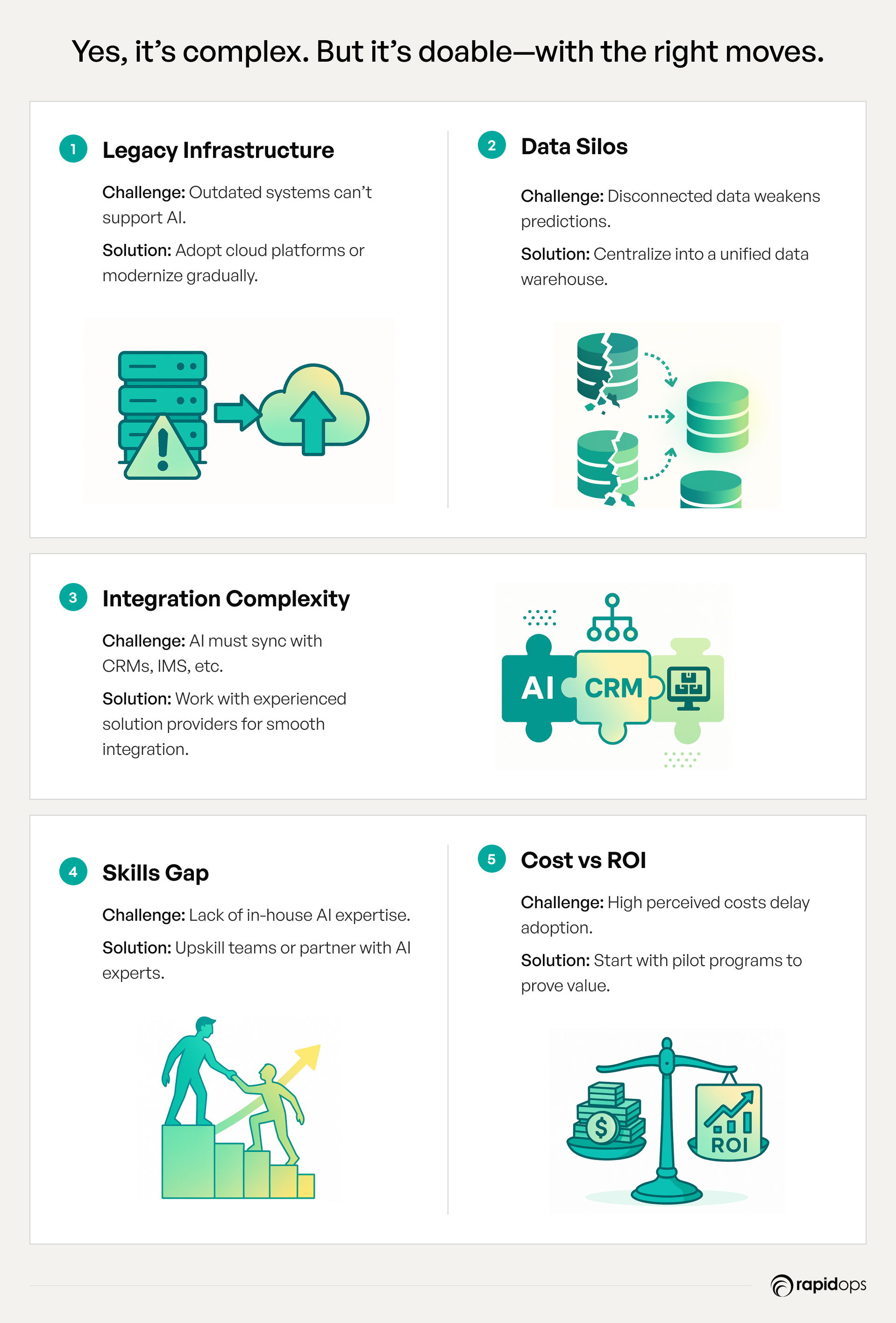
Implementing an AI recommendation system is not without its hurdles, especially in the dynamic retail industry.
Retailers face several interconnected challenges, including legacy infrastructure, data silos, integration complexities, and the need for specialized expertise.
These barriers can make adoption seem daunting, but with the right approach, they are surmountable.
Solutions to address these challenges
1. Modernizing legacy infrastructure
Legacy systems often lack the scalability and data-handling capabilities required for AI. Retailers can overcome this by adopting cloud-based AI platforms that bypass outdated infrastructure or by gradually modernizing their systems in a phased approach.
2. Breaking down data silos
Siloed data reduces the effectiveness of AI models. Centralizing data into a unified platform or data warehouse ensures the system has a comprehensive view of customer behavior, enabling better predictions and recommendations.
3. Ensuring seamless integration
Integrating AI systems with existing tools like CRM platforms and inventory management software is a critical step. Retailers can work with experienced AI solution providers to establish smooth data flow and compatibility across systems.
4. Bridging the skills gap
Lack of technical expertise can hinder implementation. Partnering with AI experts or investing in training internal teams can ensure the system is not only implemented successfully but also maintained and optimized over time.
5. Balancing costs and ROI
Retailers often hesitate due to the perceived high costs of AI. Running a pilot program or proof of concept can demonstrate clear ROI, helping stakeholders understand the long-term benefits of AI-powered recommendations.
By addressing these challenges head-on with tailored solutions, retailers can unlock the full potential of AI recommendation systems, transforming them into a competitive advantage in an ever-evolving marketplace.
Turning challenges into opportunities
While these challenges may seem daunting, they also represent opportunities for growth and innovation. Retailers who tackle these obstacles head-on can unlock the full potential of AI recommendation systems, positioning themselves as leaders in a highly competitive market.
As we’ve seen, overcoming challenges requires strategic planning and the right partnerships. But what’s next? In the final section, we’ll explore the future of AI recommendation systems and how they are poised to redefine the retail industry, offering even greater opportunities for innovation and customer engagement.
The future of AI recommendation systems: Redefining retail innovation
As the retail landscape continues to evolve, AI recommendation systems are not just tools—they are becoming the architects of futuristic, customer-first shopping experiences. Today’s systems are already impressive, offering personalized suggestions, optimizing pricing, and streamlining inventory. But what does the future hold? How will these systems transform retail in ways we can only begin to imagine?
Let’s take a visionary look at how AI recommendation systems will reshape the retail industry, turning emerging technologies and trends into opportunities for innovation.
1. Hyper-personalization: Beyond customer expectations
Imagine this:
A customer is browsing your online store during their lunch break, and just as they scroll past travel essentials, they see a personalized recommendation for a lightweight, compact umbrella. It seems like a coincidence, but behind the scenes, your AI recommendation system has just worked its magic.
By integrating real-time weather data, it predicted a rainstorm in the customer’s location and nudged them toward a product they didn’t even realize they needed yet.
This isn’t a future possibility—it’s happening now, and businesses like yours are using these capabilities to not just meet customer expectations but exceed them.
Today’s AI recommendation systems do more than analyze what customers have done in the past; they anticipate what they’ll need next.
By merging contextual data—such as weather forecasts, time of day, trending topics on social media, or even location-specific events—with historical customer behavior, these systems deliver recommendations that feel immediate, relevant, and incredibly valuable.
Example: A global apparel retailer uses this technology to suggest cozy sweaters to customers shopping in regions experiencing a cold snap, while simultaneously promoting lightweight clothing to those in warmer climates.
The result? Higher conversion rates, happier customers, and increased trust in the brand’s ability to “understand” them.
For business leaders, this kind of hyper-personalization isn’t just about delighting customers—it’s about driving measurable results.
Tailored experiences increase conversion rates, improve customer retention, and create opportunities to cross-sell and upsell in ways that feel natural and intuitive.
If you’re looking to create these kinds of impactful, data-driven connections with your customers, the question isn’t whether hyper-personalization is worth it—it’s how soon you can implement it.
2. AI and IoT integration: Bridging the digital and physical
The integration of AI with the Internet of Things (IoT) will bring unprecedented levels of convenience and connectivity.
Smart devices, from refrigerators to voice assistants, will work in tandem with AI recommendation systems to offer seamless, personalized shopping experiences.
Example: A smart refrigerator detects that milk is running low and, with the help of an AI system, automatically suggests the customer’s preferred brand at their local store or online platform. With one click, it’s delivered to their doorstep.
3. Real-time recommendations in physical stores
The line between online and offline shopping will blur as AI systems bring real-time personalization into physical retail spaces.
With technologies like augmented reality (AR) and facial recognition, in-store AI will offer tailored suggestions in real time.
Example: A customer walking through a clothing store sees personalized outfit suggestions on an AR mirror, complete with accessories that match their style preferences and purchase history.
4. Ethical AI: Building trust through transparency
As AI systems become more advanced, retailers will need to prioritize ethical practices. Future AI recommendation systems will not only deliver personalization but also ensure fairness, transparency, and inclusivity.
Example: AI systems will clearly communicate why specific recommendations are made, ensuring customers feel informed and empowered rather than manipulated. Ethical frameworks will also eliminate biases, ensuring fair treatment for all customer segments.
Building AI-powered retail success stories
The retail industry is on the cusp of a revolution, with AI recommendation systems leading the charge.
By merging hyper-personalization, real-time insights, and ethical practices, these systems will create shopping experiences that feel intuitive, delightful, and indispensable.
For retailers, the future offers an unparalleled opportunity to innovate and connect with customers on a deeper level.
As we conclude this exploration of AI recommendation systems, the message is clear: the future belongs to retailers who embrace this technology.
From overcoming challenges to envisioning groundbreaking innovations, every step of the journey is an opportunity to redefine what’s possible.
At Rapidops, we’ve worked closely with leading retail businesses to implement AI solutions that redefine customer experiences and drive business growth. Our expertise lies in building customized AI systems tailored to the unique challenges and goals of the retail industry.
From designing advanced recommendation algorithms to integrating these systems seamlessly into existing infrastructures, our solutions have helped retailers:
- Boost customer engagement: By delivering hyper-personalized product recommendations.
- Increase revenue: Through dynamic pricing strategies and effective cross-selling.
- Optimize operations: Leveraging predictive analytics for better inventory and supply chain management.
Our past projects include:
- AI-powered e-commerce transformation: Enabling a global retailer to double its conversion rates through a hybrid recommendation model.
- Omnichannel retail experience: Developing an AI system that bridges online and offline customer journeys, increasing in-store sales by 30%.
Are you ready to lead this transformation? Speak to our AI experts today to explore how recommendation systems can elevate your retail strategy and deliver unforgettable customer experiences.
Frequently Asked Questions
What types of algorithms power AI recommendation systems?
How do AI recommendation systems improve inventory management for retailers?
What challenges do retailers face when integrating AI recommendation systems?
How can retailers implement hyper-personalized recommendations using AI?
What’s Inside
- How AI recommendation systems work
- Use cases of how AI enhances customer experiences
- Why retailers love AI recommendation systems
- Overcoming Challenges: Integrating AI recommendation systems
- The future of AI recommendation systems: Redefining retail innovation
- Building AI-powered retail success stories

